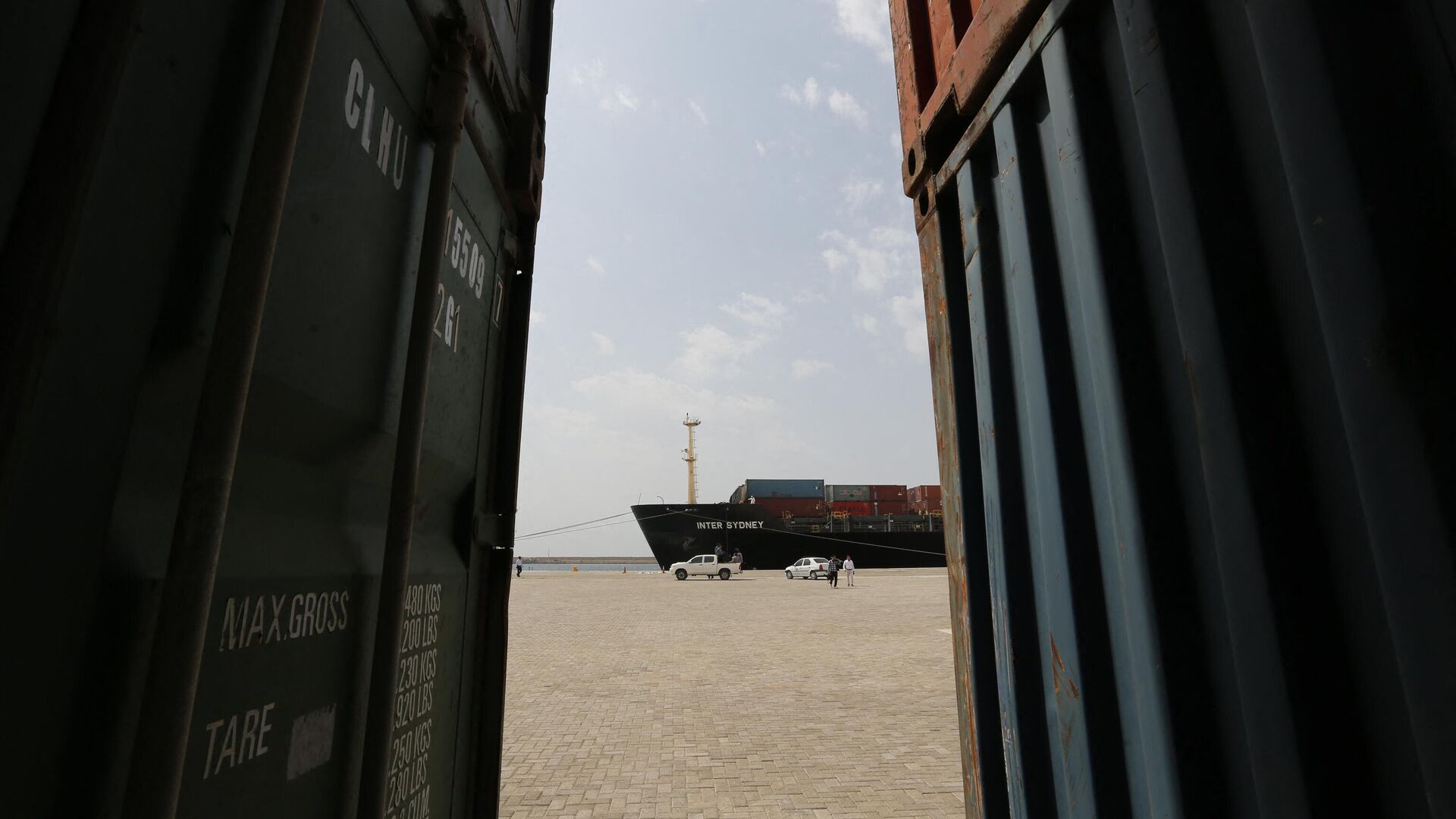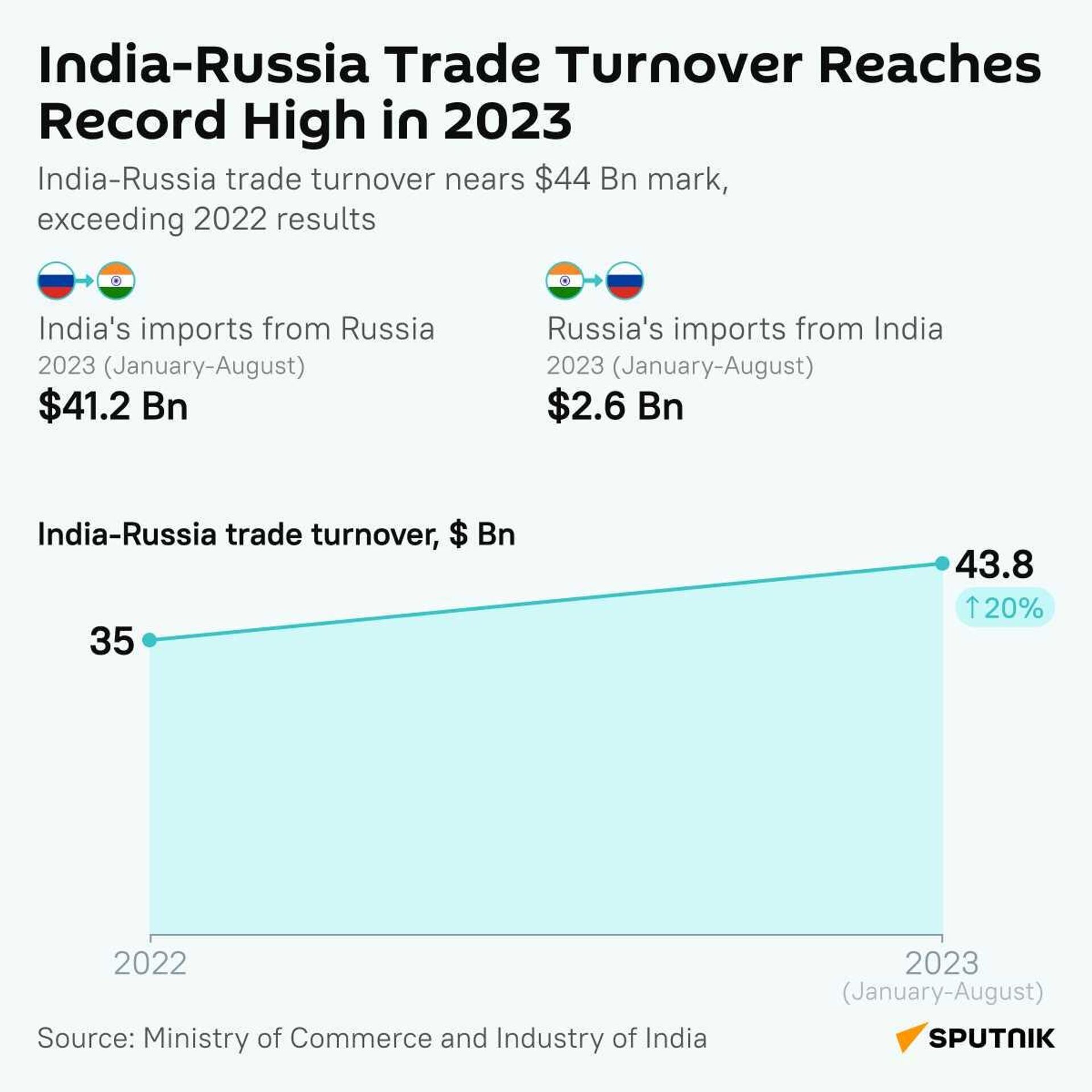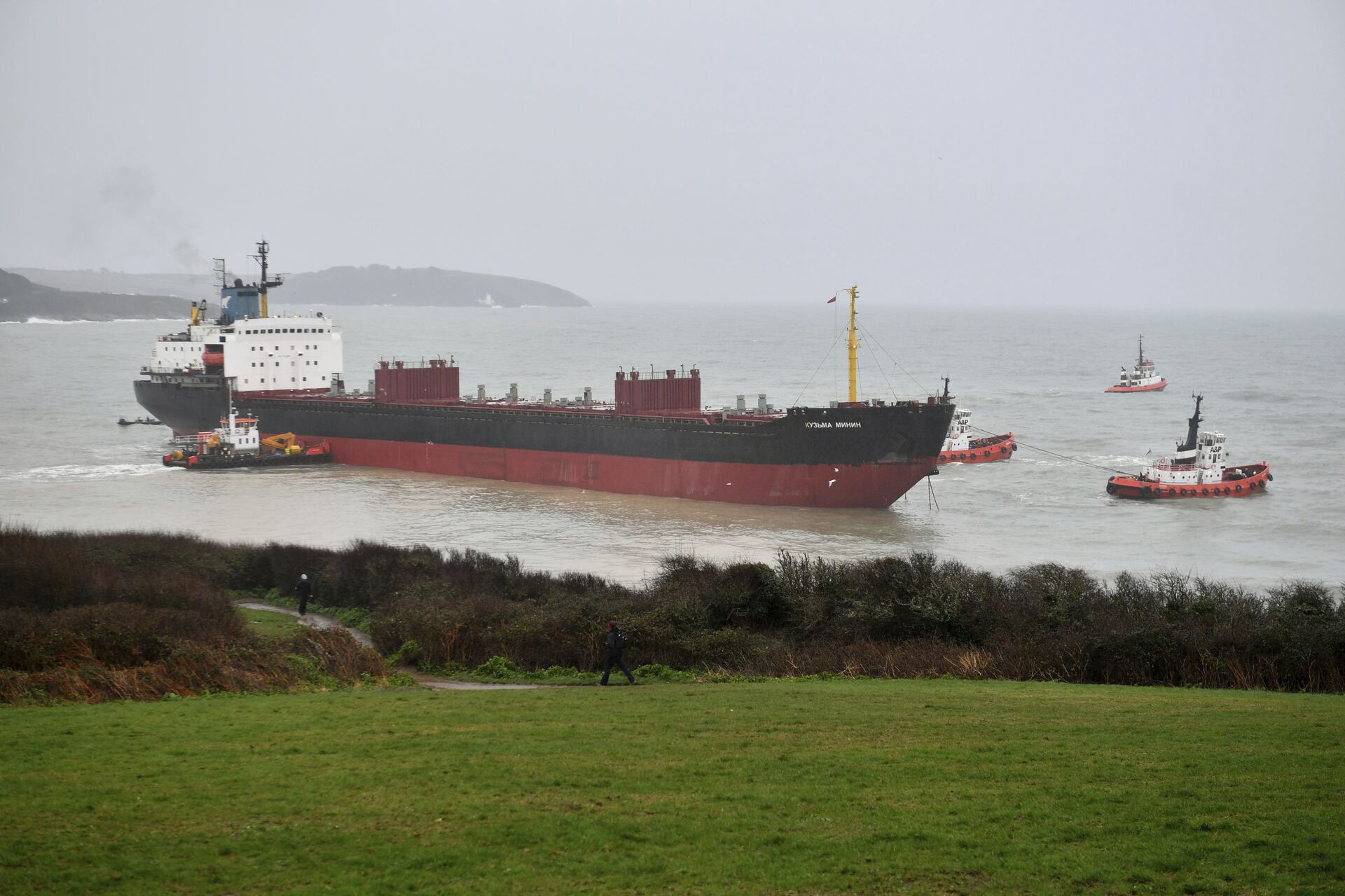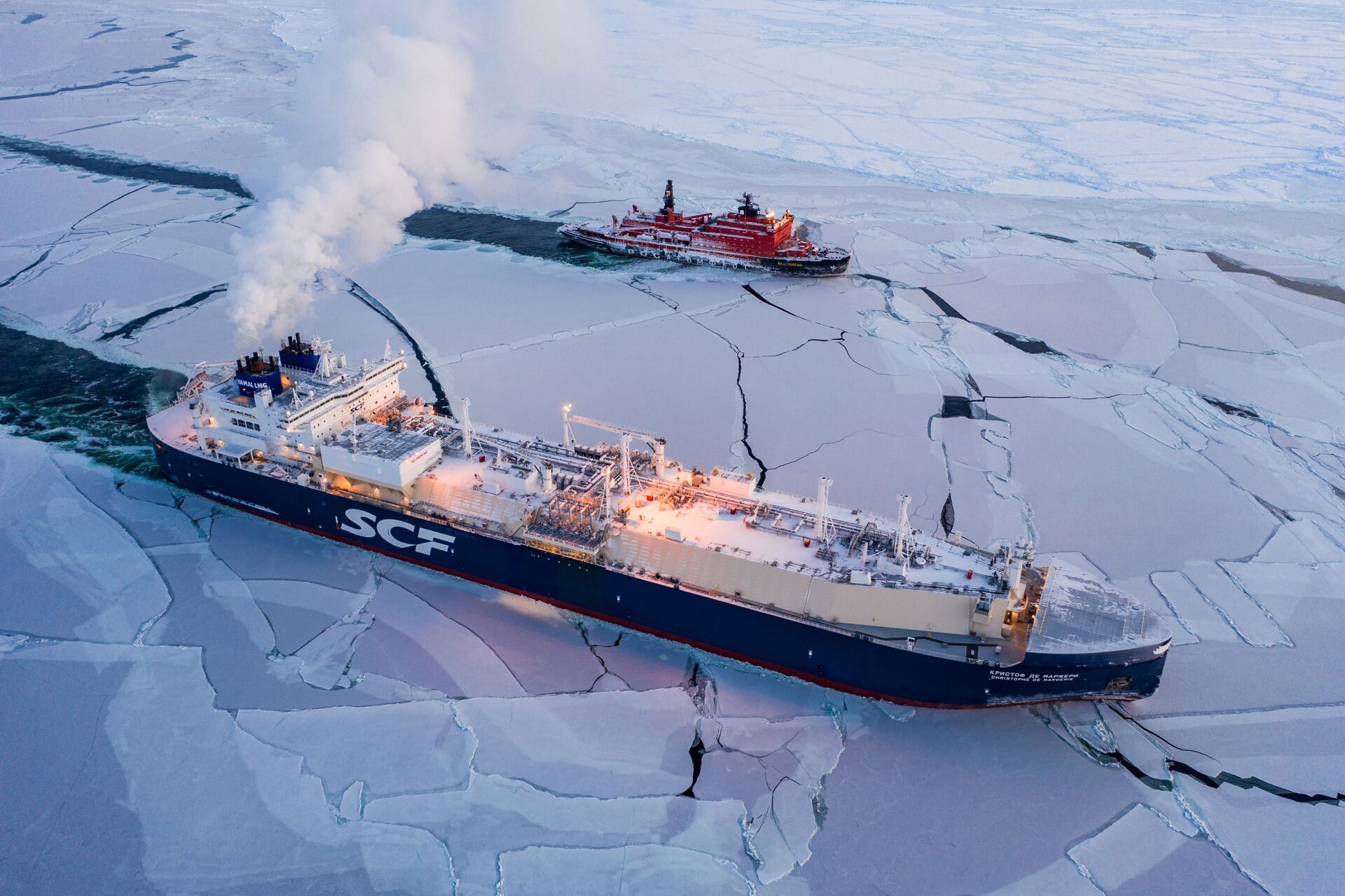Indian-Russian Trade Thrives Amid Western Pressures
20:15 07.11.2023 (Updated: 18:20 10.11.2023)

© AFP 2023 ATTA KENARE
Subscribe
In his column for Sputnik India, Vijainder K Thakur, an Indian expert, explores the effect of the construction of 24 river-sea class cargo ships on trade relations between India and Russia, given the current Western sanctions.
Introduction
India has signed a government to government deal to build 24 river-sea class cargo ships for Russia by 2027.
Dmitry Dubovik, director of the Caspian International North-South Integration Club announced the deal during the Astrakhan International Forum in Russia in October, which brought together stakeholders involved in the development of the proposed 'International North-South Transport Corridor (INSTC).
“The advantages of cooperation with India are that the cost will be lowered by almost half to that of Russian manufacturers,” Dmitry Dubovik highlighted to the participants.
The project, according to Dubovik’s statements at the conference, will be financed by the Russian Agency for Export Credit and Investment Insurance (EXIAR), through the Russian Export Center (REC).
The ships will be built at Indian state-owned Goa shipyard limited (GSL). It may be recalled that Russia earlier provided GSL technical assistance to build Project 11356M (Updated Talwar Class) frigates for the Indian Navy, which currently operates six Talwar-class frigates acquired from Russia in the early early 2000s and early 20210s.In 2019, India's Ministry of Defences (MoD) awarded GSL a contract to build two more updated Project 11356M frigates locally for delivery in 2025 to 2026.
The Indo-Russian project to build 24 river-sea class cargo ships will be financed by the Russian Export Credit and Investment Insurance Agency (EXIAR), through the Russian Export Center (REC).
No Ordinary Deal!
The contract awarded to GSL goes beyond just being a major trade deal because it
1.
Clears a logjam in India's trade relations with Russia on account of a massive trade imbalance2.
Helps create the infrastructure for 'International North-South Transport Corridor (INSTC) 3.
Relieves pressure on the Russian shipbuilding industry 4.
Helps India become a global player with its shipbuilding industryTrade Imbalance
As we pointed out in an earlier Sputnik India analysis, an unprecedented rise in India's oil imports from Russia, following the start of the Russian Special Military Operation (SMO) in Ukraine on February 24, 2022, led to a massive trade imbalance between India and Russia. US sanctions targeting Russia, limit India's ability to clear its imports bills through bank transfer payments. The logical option was to increase Indian exports to Russia.

Crude oil
© AP Photo / PANKAJ NANGIA
Both countries have been working hard to identify Russian requirements that could be met through Indian exports.
In April, India and Russia announced that they were working to conclude an intergovernmental agreement on shipbuilding and ship repair.
The Indian ambassador to China, Pawan Kapur, while on a visit to Astrakhan City at the time said, “I would like to suggest that Astrakhan-based companies consider the possibility of using their competencies and ship personnel at our shipyards in India.
“I am participating in negotiations with Russia’s United Shipbuilding Corporation (USC). We will see how these two interests can be combined."

India-Russia trade turnover nears $44 Bn mark, exceeding 2022 results, doc
© Sputnik
International North-South Transport Corridor (INSTC)
Besides being a big export success that addresses India's trade imbalance with Russia, the contract will help operationalise the International North-South Transport Corridor (INSTC).
Currently, Indian trade with Europe and Russia is mostly by sea through the Suez canal. Sea routes are prone to disruption due to geopolitical instability and can whimsically be shut down by a hegemon with global reach, like the US.
In order to facilitate and sustain the meteoric rise in trade volume between India and Russia, India is seeking and investing in alternative trade routes that are secure and economical.
The International North–South Transport Corridor (INSTC) is a 7,200-km long multi-mode network of ship, rail, and road routes for moving freight between India, Iran, Azerbaijan, Russia, Central Asia and Europe.
As far as India is concerned, the primary objective of the INSTC project is to reduce costs in terms of time and money over the traditional route currently being used between India and Russia.
The INSTC connects Russia and India across the Caspian Sea through Iran.
Using the INSTC, Indian goods would move by ships from an Indian port to Chabahar port in Iran; onwards through Iran over land to the Caspian shore; again on ships to the Russian Caspian shore and finally on rail or on ships in the Volga river to their destination in Russia.
In this context, it's worth noting that India is also a major investor in Iran's Chabahar port. It takes just 36 hours for the voyage from Mumbai to Chabahar.
The Volga, which is the longest river in Europe. flows through Central Russia to Southern Russia and into the Caspian Sea. Four of Russia's largest cities, including Moscow, are situated along the Volga.
According to Dubovik, the plan is to build vessels as part of the effort to expand shipping on the Caspian Sea. The first four ships are to be launched in 2024, coming from the Goa Shipyard. They will include chemical carriers, bulk carriers, and containerships tailored to the service.
Russian Shipbuilding Industry
With Russia subject to across the board economic sanctions from the West, its shipbuilding sector is stretched for want of ship building equipment. The domestic supply chain for key components will take time to fill the gap. Russia is reportedly also facing a shortage of skilled labour.
Since the start of the Ukraine conflict in 2014, the Russian government has promoted development of its domestic shipbuilding industrial base, and frowns upon private Russian operators placing orders on foreign vendors.
In the past, Russia detailed plans to build custom-built container ships for the INSTC. Now, however, Russia is seeking partnerships with friendly shipbuilding nations such as India and China.

Tugs manoeuvre the Kuzma Minin, a 16,000-tonne Russian cargo ship, as attempts are made to refloat it after it ran aground off Gyllyngvase Beach in Falmouth, south west England, Tuesday Dec. 18, 2018
© AP Photo / Ben Birchall/PA
Global Shipbuilding Player
The river-sea class cargo ships dovetails beautifully into the Indian government's declared intent to expand its shipbuilding industry to become a global player in meeting Russia's needs.
Ice Class Ships
In September, it was reported that Russia is seeking shipbuilding support from India and China to build ice class ships in order to increase the number of ships transiting through its Northern Sea Route (NSR).
Ice class ships are strengthened to operate in difficult ice conditions. Top class ice ships can navigate through ice mostly without icebreaker assistance. Lower class ice ships need icebreaker assistance.

Sovcomflot LNG ship Christophe de Margerie and Russian icebreaker 50 Let Pobedy traverse the Northern Sea Route in February 2021, the first commercial cargo vessel to do so
At present, the NSR handles about 35 million tonnes of cargo a year; President Putin would like to increase that to 200 million tonnes by 2031.
Russia currently has six nuclear-powered icebreakers that can plough through the frozen sea and create a passage for merchant ships to navigate through. Of these, three will be retired by 2027, according to deputy security council chairman Dmitry Medvedev.
The NSR Directorate assesses the minimum requirement of Icebreaker ships for year-around navigation to be 7, with the preferred number being 12-14.
"If they are not replaced in the near future with new vessels of modern designs . . . then by 2030 there is a risk of facing a shortage of icebreaking capacities,” Medvedev told Vedomosti last year.
Russian plans envisage a fleet of 50 ice-class and Icebreaker ship by 2035, a number that is definitely beyond the reach of the Russian shipbuilding industry as of now.
Chinese shipyards have built both icebreakers and ice class ships, while Indian shipyards have built neither.
According to the head of the Ministry for the Development of the Russian Far East, Alexei Chekunkov, “India is interested in working together to develop northern navigation and potentially in joint shipbuilding . . . Somewhere together we will be able to produce an ice-class fleet in sufficient quantities.”
Conclusion
The Russian leadership's willingness to order ships from India is indicative of its confidence in the enduring nature of the relationship between the two nations.
The order for 24 ships from GSL will not only reduce India's trade imbalance with Russia, it will also promote early operationalisation of the INSTC and raise India's status as a shipbuilding nation.
The order is indicative of a strong desire on the part of Russian and Indian political leaders to not just maintain but further strengthen their strategic partnership defying Western pressures on India to tone down its relations with Russia.
Finally, the deal is a harbinger of further increase in trade between the two nations. Earlier in November, the Consul General of India in St. Petersburg said in an interview with IAA PortNews on the sidelines of the St. Petersburg International Gas Forum’s session that India is interested in increasing coal supplies from Russia taking advantage of the INSTC.


